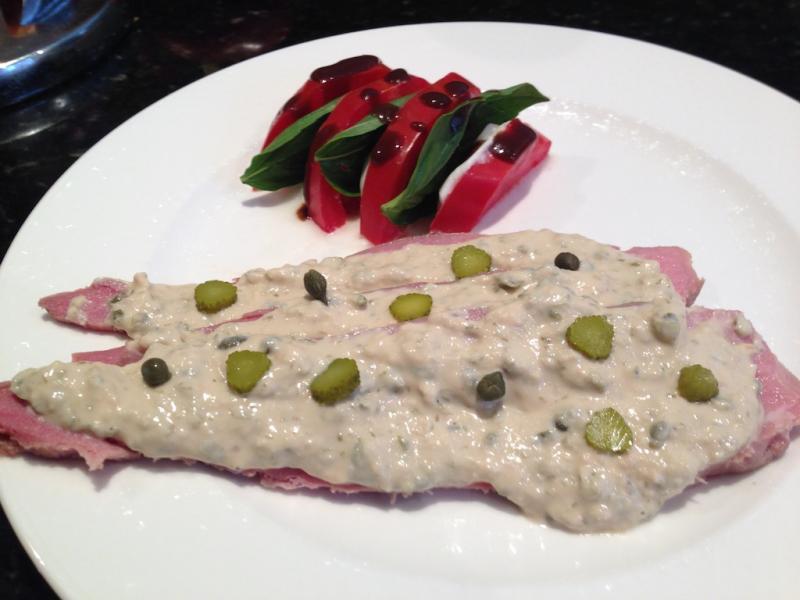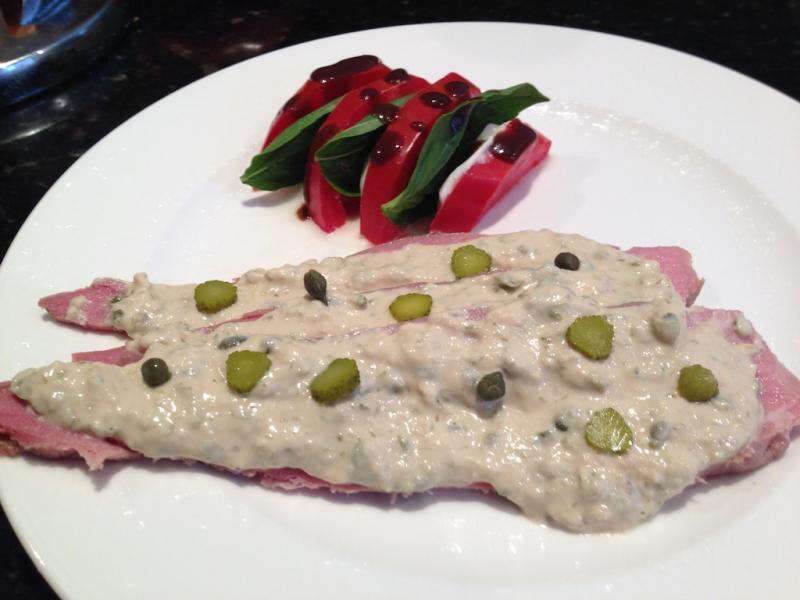-
Posts
2,606 -
Joined
-
Last visited
Content Type
Profiles
Forums
Store
Help Articles
Everything posted by nickrey
-
I use a grill pan at very high heat (on the wok burner on my stove top). To cook, put oil (I use grapeseed) onto the room temperature steak rather than onto the pan, add salt. Place steak on extremely hot pan for a few minutes, turn 90 degrees (gives good -looking grill marks). Turn and do same on the other side. Turn off heat. Rest on cake rack on top of pan for about half the cooking time. Serve.
-
I put mine in 80C water for a short period. It gives a more conventional exterior to the poached egg and warms the inside up for service. It is similar to searing the outside of a sous vide cooked steak on a very hot pan to give a conventional seared effect.
-
As Hassouni says this has more to do with its the egg. As an egg ages the white becomes thinner. This happens from the outside in. Thus when you cook an egg in the shell, particularly with an older egg, the more liquid part cooks differently from the more solid part. This is why many of us put eggs in some form of strainer prior to poaching. Doing so stops those spindly egg threads that you get if you put it in without straining. In a whole egg there is nowhere for this to go and it tends to stick to the shell. I'd suggest that Dave, like most chefs, used very fresh eggs. When I use the egg topper shown above, some white always sticks to the shell. I also tend to remove any separate white by rinsing gently under cold water prior to reheating.
-
I have many sous vide machines but unless I'm cooking the protein sous vide I use the sink with water at around 55C (I say around as I dunk my hand in it to check the temperature). I don't know why you'd go lower in temperature as this is around what you'd cook it at sous vide anyway. Takes a lot less than an hour and it doesn't affect the texture for cooking. The meat is not in the danger zone for significant periods of time.
-
What happened to tasting and adding seasoning according to what it needs? It seems we want cookbook authors to hand hold us on everything. Add unsalted and then salt to taste or add salted and then add less to taste. The main problem would be using salted in a dish that has many added salt components (bacon, soy sauce, fish sauce, etc). In these cases, I'd stick to unsalted and then add if it needs it.
-

Recs for newer "modern cooking" chef's cookbooks
nickrey replied to a topic in Cookbooks & References
To make it even more confusing, Anne-Sophie Pic's "Le Livre Blanc" is also a fantastic cookbook. -
The best Nasi Goreng I've had has been eaten at breakfast in Indonesia, hence my retreat to Indonesia for the best examples and recipes. Our experiences govern what we consider to be the prototype of the dish and judging from the great discussion here we have varying experiences with this particular fried rice dish.
-

Recs for newer "modern cooking" chef's cookbooks
nickrey replied to a topic in Cookbooks & References
All good suggestions. I'd also support Martin Benn's new book "Sepia," as well as Pascal Barbot's "Astrance A Cook's Book," "Le Strato Courchevel," the Roca Brothers "El Celler de Can Roca," and Ben Shewry's "Origin" to the list. -
All of my Indonesian cookbooks use light (salted) soy sauce rather than the sweet (manis) version in Nasi Goreng. I'd recommend Sri Owen's book "Indonesian Food" for anyone who is interested in investigating this delicious cuisine. I've put in the link to the ebook but there is also a print version. Nyonya cooking is Malaysian and, although they have great food, I'd prefer to be looking at Indonesian sources for a more genuine version of the dish. Edited to add: Here's a link to Owen's recipe on Epicurious. The discussion in the recipe's rating on the site suggests that finding an "authentic" recipe is going to be an uphill battle.
-
The links worked for me. You just need to to use them at the website rather than downloading the document and then clicking.
-
Try this link. It has forms for HACCP for cook/chill and sous vide cooking embedded in the document.
-
No need to roast them for that dish, just substitute them for the fresh.
-
French butter, like much European butter, is typically cultured and unsalted. This has a totally different flavour before you start considering the type of cow and what it ate.
-
Check out the Risotto thread for a discussion of this and many other issues. After using all three different types of rice to make risotto, I observed that the fluid uptake varied between the different types of rice and that the end product varied in terms of bite. The response from Scarpetta was that "here in Italy Arborio and Carnaroli are generally used when preparing meat risottos or plain milanese and piedmontese white risotto with truffles. Vialone Nano is preferred for vegetable and seafood risottos. It does absorb more liquid and has a slightly different bite. In my opinion it's also a little tastier than the other two. Of course, all three can be used for any risotto with good results." When you cook risotto, no matter which rice is used, you need to taste to see when the correct amount of bite is reached. It also needs to be rested before being served so stopping just slightly before your preferred texture is best.
-
My information is that the IOS app will be released soon, followed closely by Android and Windows.
-
This would work if the steak was kept out of the danger zone (>5C/41F) for less than four hours, including cooking time.
-
I weigh everything. Sydney is very humid at the moment. Perhaps Shirley has never been to a really humid place. It's all relative.
-
Try lecithin. Add a small amount to the gravy (check on the Internet for quantities) and then hit it with a stick blender. Voila, instant gravy foam.
-
Like many avid followers of food, I always followed the conventional wisdom that cooking was all art and not measuring and baking was precise and full of accurate measurement. Baking was the ancestor of molecular gastronomy.. Or so I always thought. After having done much bread baking in recent times, this facade has fallen away for me. Follow the precise measurements of a recipe for bread and, guess what, most often it will fail (too sticky, typically, in my side of the world). If baking is all precision, shouldn't a recipe always turn out if you measure carefully? Turns out that flours have different hydration properties and what works in one kitchen with one type of flour will fail in another kitchen. I can understand that having a precise recipe in a particular kitchen that uses one type of flour from the same source may be accurate, but even then there is relative humidity to tackle, which will definitely have an effect on relative proportions. So I'd propose that baking's dirty little secret is that the recipe gives a general guide and then you need to add more ingredients to balance up the mix to make it appropriate for baking. Sure, I suspect every baker knows this. But why pretend that baking is more precise than other forms of cooking, which also need to adjust ingredients according to conditions? Let's put this into every baking book and start talking about feel of the flour (we get told that the resultant mixture should be sticky but that's a long continuum). Comments please!
-
After converting the measurements to metric, I can understand what happened. After an hour and a half, steaks as thick as you used would only have reached around 118F. This is well below blue and suggests that the "juice" is most likely that found in under-cooked steak. Such a steak will be very soft in the middle (think raw meat), whether sous vide cooked or not. We've discussed levels of doneness at some length on eGullet. A general consensus at one stage was that rare steaks are 50-54.9C (122F - 130F); medium rare are 55-59.9 (131F - 139F); medium 60-64.9 (140F-148F). These are the core temperatures, as discussed above a conventional steak will have warmer temperatures outside the core increasing a gradient to the exterior. If you have an iPhone, do yourself a favour and get the Sous Vide Dash app. This will allow you to work out how long the meat has to be cooked and at what temperature to achieve the result that you desire. For searing, you need an extremely hot pan (cast iron starting to look white). At this temperature, any butter or thyme is going to be incinerated. Make sure the steaks are very dry (I use paper towel) before browning. You are trying to achieve a maillard effect similar to what you get when you first put an uncooked steak over very high heat. If you want to use butter and thyme, let the steaks rest a bit after browning and spoon melted butter and thyme over them while they are on a more reasonable heat.
-

Victorian curry recipe. We have come a long way.
nickrey replied to a topic in Food Traditions & Culture
The book "Culinary Jottings for Madras, Or, A Treatise in Thirty Chapters on Reformed Cookery for Anglo-Indian Exiles" was written by Colonel Arthur Robert Kenney-Herbert (nom de plume, Wyvern) in 1878. This has a curry recipe that I have used to good effect in recent times. It does involve the making of a curry powder but if ground fresh, I challenge anyone to tell it apart from true Indian curries made with freshly ground masala. This curry recipe nine years later obviously missed the use of coconut milk, etc that was in the earlier recipe. Methinks the journalist doesn't know much about the history of curry in England, despite referring to Lizzie Collingham's solid book on the subject. -
Check out this link. It is a label printer for the Brother P-Touch PT-2430PC that puts all the information into q-code, which is readable from your mobile phone.
-
Posted this over on the sous vide cooking thread but thought it also had a home here. Also I haven't posted here for a long time. Vitello Tonnato with Salata Caprese.
-
I had some veal in the freezer and decided to do something summery with it. Cooked it at 57C for around three hours (to pasteurisation) and then quick chilled in ice bath and into the refrigerator. Today I made up some tuna/mayonnaise sauce and made Vitello Tonnato. Served it with a constructed Insalata Caprese (fresh tomato, buffalo mozzarella, and basil).
-
Fatty liver




